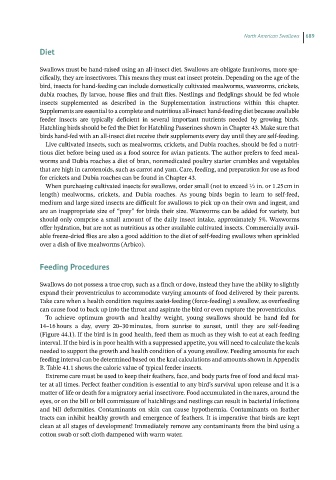Page 688 - Hand rearing birds second
P. 688
North American Swallows 689
Diet
Swallows must be hand‐raised using an all‐insect diet. Swallows are obligate faunivores, more spe-
cifically, they are insectivores. This means they must eat insect protein. Depending on the age of the
bird, insects for hand‐feeding can include domestically cultivated mealworms, waxworms, crickets,
dubia roaches, fly larvae, house flies and fruit flies. Nestlings and fledglings should be fed whole
insects supplemented as described in the Supplementation instructions within this chapter.
Supplements are essential to a complete and nutritious all‐insect hand‐feeding diet because available
feeder insects are typically deficient in several important nutrients needed by growing birds.
Hatchling birds should be fed the Diet for Hatchling Passerines shown in Chapter 43. Make sure that
birds hand‐fed with an all‐insect diet receive their supplements every day until they are self‐feeding.
Live cultivated insects, such as mealworms, crickets, and Dubia roaches, should be fed a nutri-
tious diet before being used as a food source for avian patients. The author prefers to feed meal-
worms and Dubia roaches a diet of bran, nonmedicated poultry starter crumbles and vegetables
that are high in carotenoids, such as carrot and yam. Care, feeding, and preparation for use as food
for crickets and Dubia roaches can be found in Chapter 43.
When purchasing cultivated insects for swallows, order small (not to exceed ½ in. or 1.25 cm in
length) mealworms, crickets, and Dubia roaches. As young birds begin to learn to self‐feed,
medium and large sized insects are difficult for swallows to pick up on their own and ingest, and
are an inappropriate size of “prey” for birds their size. Waxworms can be added for variety, but
should only comprise a small amount of the daily insect intake, approximately 5%. Waxworms
offer hydration, but are not as nutritious as other available cultivated insects. Commercially avail-
able freeze‐dried flies are also a good addition to the diet of self‐feeding swallows when sprinkled
over a dish of live mealworms (Arbico).
FeedingProcedures
Swallows do not possess a true crop, such as a finch or dove, instead they have the ability to slightly
expand their proventriculus to accommodate varying amounts of food delivered by their parents.
Take care when a health condition requires assist‐feeding (force‐feeding) a swallow, as overfeeding
can cause food to back up into the throat and aspirate the bird or even rupture the proventriculus.
To achieve optimum growth and healthy weight, young swallows should be hand fed for
14–16 hours a day, every 20–30 minutes, from sunrise to sunset, until they are self‐feeding
(Figure 44.1). If the bird is in good health, feed them as much as they wish to eat at each feeding
interval. If the bird is in poor health with a suppressed appetite, you will need to calculate the kcals
needed to support the growth and health condition of a young swallow. Feeding amounts for each
feeding interval can be determined based on the kcal calculations and amounts shown in Appendix
B. Table 41.1 shows the caloric value of typical feeder insects.
Extreme care must be used to keep their feathers, face, and body parts free of food and fecal mat-
ter at all times. Perfect feather condition is essential to any bird’s survival upon release and it is a
matter of life or death for a migratory aerial insectivore. Food accumulated in the nares, around the
eyes, or on the bill or bill commissure of hatchlings and nestlings can result in bacterial infections
and bill deformities. Contaminants on skin can cause hypothermia. Contaminants on feather
tracts can inhibit healthy growth and emergence of feathers. It is imperative that birds are kept
clean at all stages of development! Immediately remove any contaminants from the bird using a
cotton swab or soft cloth dampened with warm water.

